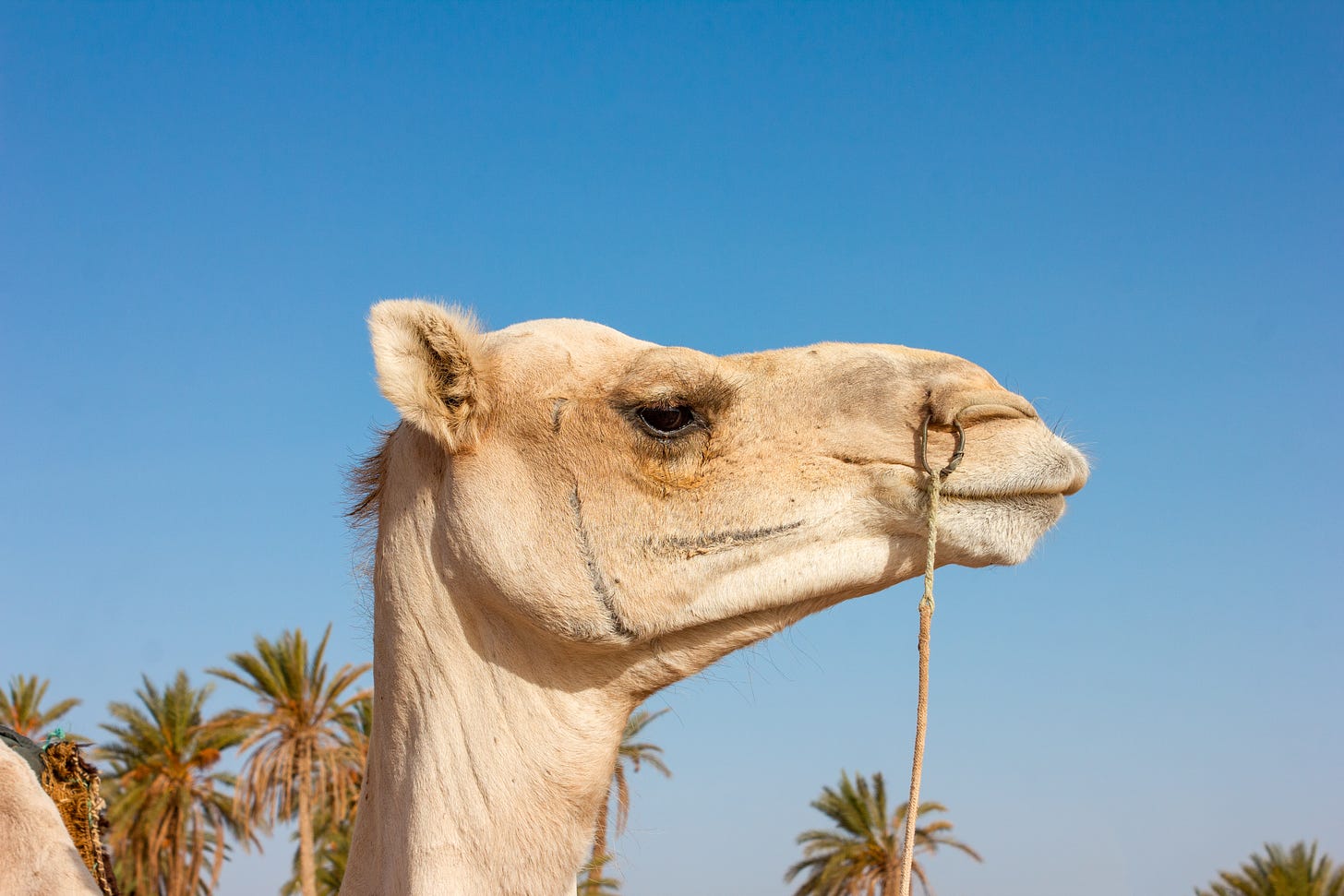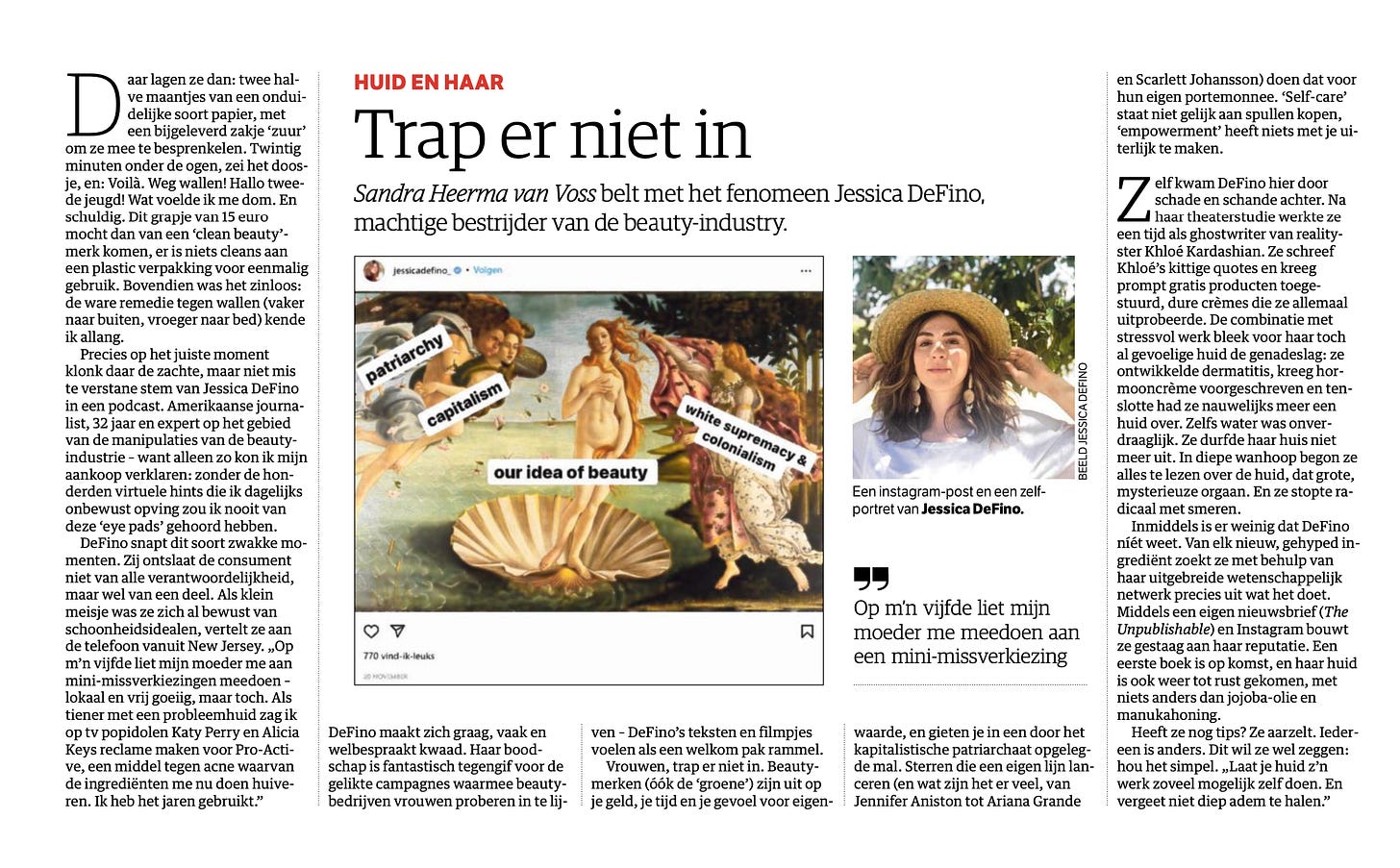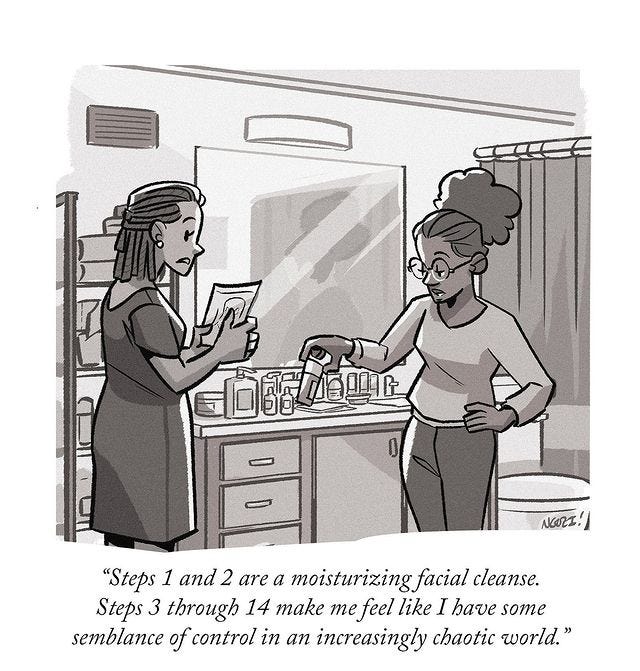The Don't Buy List: Sparkly Cell Death, Blonde Jokes, & Botox For Camels
Plus, skincare sneakers: the nadir of beauty brand collabs.
Hello, dewy dust bunnies, and welcome to another edition of the The Don’t Buy List — the last one of the year! Let’s kick things off with an existentialist blonde joke. Alex Baia recently wrote a collection of them for The New Yorker, and they’re all laugh-inside-your-head funny (a very under-appreciated kind of funny, I think).
A blind man walks into a bar. He sits down and says, “Who wants to hear a dumb-blonde joke?”
The bartender says, “I’m actually blond! But I’d love to hear your joke, since stereotypes about my hair color help me explore my sense of anxiety about things I can’t control.”
I’m sorry, that’s not even the whole joke, but come on, how good is that line?? You can read the rest here.
Anyway!
A bunch of camels were disqualified from a camel beauty contest in Saudi Arabia after getting Botox. “Authorities discovered dozens of breeders had stretched out the lips and noses of camels, used hormones to boost the beasts’ muscles, injected camels’ heads and lips with Botox to make them bigger, inflated body parts with rubber bands, and used fillers to relax their faces,” according to Al Jazzera. The internet generally laughed at the absurdity of it all, with takes along the lines of, “Botox for camels? How weird! How cruel! How absolutely ridiculous!” And, like… Yes. Altering one’s appearance with cosmetic procedures in order to better adhere to some arbitrary standard of beauty that doesn’t actually exist in nature is absurd. But if it’s absurd for camels… isn’t it absurd for human animals? Press coverage of the event side-stepped my burning philosophical question by pointing out that “camels didn’t elect to have” these elective procedures (which, of course, is true — this is animal cruelty and it’s wrong, disturbing, etc). But do we elect to have these procedures? I don’t think so; not fully. I’m thinking about this quote from the recent Air Mail piece on journalist Stephen Glass: “Years in therapy and long discussions about lying made him realize it is poisonous to others, because it ‘deprives them of agency—the ability to make judgments and determinations’ on their own.” Not to be dramatic, but beauty culture is built on lies — lies about our worth, lies about our “flaws,” lies about what we lack and what we need, lies about our cultural and moral duty to look young and beautiful, lies about how we will feel and the rewards we will reap once we buy into society’s beauty standards. That’s why I cringe whenever someone equates getting cosmetic surgery/injectables with exercising “body autonomy.” You can’t have body autonomy without brain autonomy, without emotional autonomy — and so often, beauty culture brainwashes us out of that autonomy, that agency, that “ability to make judgements and determinations” on our own. I mean, if our decisions are coerced by outside forces, if they’re manipulated by marketing, are they really ours? I don’t know! I started reading an article about camels and now I’m here! I am clearly unwell!!
The Beautywell Project put together a great informational PDF about Body Dysmorphic Disorder, a condition that will surely become more widespread in our increasingly virtual, overly-filtered world. “Body dysmorphic disorder (BDD) is a mental health problem that can make people be very angry with their body's appearance and unable to live a normal life,” it explains. This slide really stuck out to me:
“Myth #2: Cosmetic & Surgical procedures can magically cure Body Dysmorphia.
This is FALSE. Usually deep down, body dysmorphia is caused by trauma, anxiety, and depression. Getting plastic surgery is a SYMPTOM. Seeking these procedures can actually make the person feel worse, or want more surgeries.”
For more information on BDD, out the full presentation here.
Formerly-indie skincare brand Youth to the People was bought by L’Oreal. In a statement, YTTP founders say they’re “excited” to further their “mission” of manufacturing products that are “good to the planet and good to the people.” My question is: Can you be “good to the planet” while accelerating global growth through a highly-polluting cosmetics conglomerate? Whatever the actual answer, this move makes me sad. “Good to the planet,” to me, means deceleration. It means de-prioritizing growth. It means less industrialization. It means small, meaningful brands servicing small, meaningful communities.
You know I love a critical analysis of self-care culture! Here are two that made me think this week.
“Self Care” by B.D. McClay for The Hedgehog Review: “Every critique of self-care—that it glorifies consumption, promotes self-absorption, and represents an individual retreat from public life—is true,” the author writes. “Unfortunately, you still have to take care of yourself.”
“The Human Body Is The Final Frontier” by Zoe Tinnes at Heartability: “Wellness is a commodity, a source of economic value — it contributes to our GDP (Purser),” she states. “Helping people truly attain wellness and beauty would, technically, hurt the economy.”
Some personal news: Yesterday I was profiled by Sandra Heerma van Voss for NRC, a newspaper of record in the Netherlands. The article is in Dutch and my Google Translation seems a little off, but apparently one sentence reads “DeFino likes to get angry, often and eloquently.” I've never felt more seen!
‘Tis the season for sparkly makeup and by extension, sparkly cell death. As The Guardian reports, “Microplastics pollution has contaminated the entire planet, from the summit of Mount Everest to the deepest oceans. People … consume the tiny particles via food and water as well as breathing them in.” This isn’t news — we’ve known this for a long time. What we didn’t know is what kind of impact, if any, ingesting microplastic particles has on the body. But new research shows “specific types of harm — cell death, allergic response, and damage to cell walls — were caused by the levels of microplastics that people ingest.” The researcher leading the study elaborated, “Harmful effects on cells are in many cases the initiating event for health effects. We should be concerned. Right now, there isn’t really a way to protect ourselves. Once the plastic is in the environment, we can’t really get it out.” Reminder: Glitter is literal microplastic. So this New Year’s Eve, for the sake of your cells and everyone else’s, consider skipping the sparkles.
Unpopular opinion, apparently (?): Skincare companies should not sell sneakers. Per a new Glossy report, Florence by Mills (actress Millie Bobby Brown’s product line) recently put out a pair with Converse, Humanrace (Pharrell Williams’ brand) consistently works with Adidas, and Summer Fridays (influencer Marianna Hewitt’s company) collaborated with APL last year. Even as a former Marketing Director, I do not understand this trend. Skincare has nothing to do with sneakers. Skincare-branded sneakers don’t offer anyone anything of value. They don’t better the world in any way; in fact, pointless products like these are hastening its decline. So why would a beauty brand bother with a project like this?? Because wearable merch is marketing that customers pay for and distribute themselves, I guess — it turns consumers into walking (unpaid) advertisements, and brands are so desperate for sales, they don’t seem to care what they’re selling anymore. (Honestly, what is the proposed customer journey from Converse to cleanser? There isn’t one!) Humanrace co-founder Rachel Muscat basically said as much in what is perhaps the most depressing quote I’ve ever read: “We already knew that we were going to do more than beauty … We call ourselves a product brand.” Excuse me… A PRODUCT BRAND?! It’s not like I have a particular soft spot for skincare brands (lol), but a product brand??? That is bleak! What’s the mission there? What’s the purpose? What’s the point beyond SELL MORE STUFF? Truly, I don’t think brands like this belong in the beauty industry at all. Beauty is emotional. Beauty is tied to identity. For better or worse, beauty impacts self-worth. We deserve brands that understand the weight of that; at the very least, we deserve better than brands that don’t give a fuck what we buy so long as we buy something.
Speaking of Glossy… The industry publication just released the “Glossy 50,” its year-end list of “people who shaped fashion and beauty” in 2021. Categories include “Disruptors” (LITERALLY ALL BRAND FOUNDERS, HOW IS THAT DISRUPTIVE!?) and “Thought Leaders” (LITERALLY ALL EXECUTIVES OF GIANT CORPORATIONS LIKE WALMART AND P&G!!). The icing on the irreformable cake: The feature was sponsored by Amazon. When Amazon — bastion of consumerism! symbol of ecosystem- and employee-killing “convenience”! a company whose CEO spent the year exploiting vulnerable workers, widening the wealth gap, and riding a dick-shaped rocket into space while the Earth warmed, flooded, and caught fire below! — is sponsoring your “industry-changing” content? Yeah, that industry is never gonna fuckin’ change.
Related: A handful of “How Insiders Want The Beauty Industry To Change In 2022”-esque articles came out this week. No one asked me, but here’s what I think anyway:

There’s so much more I want to say and so little time to transform my blobby, amorphous thoughts into words! And so, a recommended reading list:
Like drag, “yassification” highlights the social construction of gender (in general) and beauty standards (more specifically).
Negative body talk among friends may harm your mental health, reports The Lily. Read the article, then remind yourself that talking shit about too-small lips, age-induced wrinkles, or occasional breakouts counts as negative body talk, too.
Val Monroe of How Not To F*ck Up Your Face wrote a brilliant response to the #LetsGetOldTogether campaign from Laura Geller Beauty, which essentially uses modern “age positive” messaging to enforce the same old glorification of youth.
USA Today reported on the evolution of beauty standards in an article entitled “Glute pumping, lip plumping, skin smoothing: TikTok trends insist the body is always something to improve. At what cost?” This insight from Cary Gabriel Costello, an associate professor of sociology and director of LGBTQ+ Studies at the University of Wisconsin-Milwaukee, is so important: “This [current] aesthetic is ostensibly more ‘multiethnic,’ and less Eurocentric, which sounds like an improvement. But it can also be viewed as an appropriation by white people of features typical of Black and brown people — with white people getting all of the benefit and none of the discrimination when taking on these trending looks.”
I came across this quote form Ashanté Reese, a professor of African and African Diaspora Studies at the University of Texas at Austin, via Alicia Kennedy’s Twitter feed and it really resonated with me. “I teach a class called Food in the Racialized City, and the students love it. But there’s a period of the class where they say, ‘This is depressing, I thought we were going to celebrate different food cultures.’ … I always have to remind them that celebration and critique can and should occupy the same spaces.” This is exactly how I feel about beauty. Celebration of beauty as a political tool without critique of beauty as a political tool is just propaganda!
Finally, lots of you tagged me in this New Yorker cartoon on Instagram and ahhh, it’s so exciting to see this message in the mainstream media!
Perhaps 2022 will be the year it sinks in — the year we realize control is an illusion, the year we understand that 14-step skincare routines can only create chaos in an increasingly chaotic world. Here’s hoping!
You’re Gonna Die Someday No Matter How Young You Look,
Jessica







Jess, this is so on-point, as usual (and thank you for the unexpected shout-out). Love that Dutch treat! xo